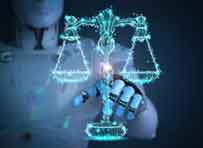The Challenging Relationship Between The Contemporary Art And Intellectual Property Rights: A Critical Analysis
A great way to protect such exceptional works of art and property is undoubtedly
through intellectual property rights. It is a difficult job that the original
artists have rights over their work given the great variety of emerging creative
forms and the rapidly expanding body of work in a technologically advanced
society where information can be disseminated in the blink of an eye.
This research paper mainly revolves around the concept of clash between contemporary art and intellectual Property Rights. This paper tries to highlight about the copyright laws related to artistic works and its view in the case of contemporary art. This paper further tries to shed light on challenges faced by Intellectual property laws due to contemporary artworks.
Introduction
In order to protect and encourage creation, IPRs were created. For artists, this area of law is particularly crucial. It guarantees that artists get the credit they deserve. Contemporary art is distinctive in that it heavily relies on redefining and reinventing itself. It seems sense that in order to give a new perspective of an old work, this needs borrowing from earlier works. Surprisingly, some people believe that the existence of IP laws poses a threat to artists and the arts. Particularly in the case of contemporary art.1
Background
Around the year 1450, Johannes Gutenberg invented the printing press and moveable type, which contributed to the creation of the first copyright system ever. The first methodical effort to safeguard inventions in the form of a patent was made by a Venetian Law in 1474. By the end of the 19th century, new inventive manufacturing techniques had contributed to widespread industrialization. The international IP system also started to take shape at this period. The benefits and recognition that come with IP ownership inspire more innovation and drives economic progress.
All forms of IP are intended to be better protected and enforced under the TRIPS Agreement. It discusses the provisions in international agreements on IP and the applicability of general GATT principles (Part I). The Agreement also establishes requirements for the IPRs' use, enforcement, compliance, acquisition, and maintenance.2
Research Questions
This research paper answers the following questions:
Contemporary art poses difficulties for intellectual property laws, particularly copyright laws.
Research Methodology
The paper follows doctrinal research, which is theoretical in character and entails a detailed analysis of legal principles as well as an assessment of legal theory and how it is created and applied. Interpretation of case law, legislation, and other legal docs is the focus of this methodology.
Citation:
Harvard Bluebook � 20th Edition
Important Terminology
Legal Protection of Artistic Works
Economic Rights:
Original literary, dramatic, musical, and creative works, as well as cinematographed films and sound recordings, are protected by copyright. Copyright holders for the aforementioned works are granted economic rights u/s 14 of the Act. MORAL RIGHTS: The Act's Sec 57 outlines the two fundamental "moral rights of an artist." These include the rights to paternity and to integrity.
Test of Sustainability
The process of determining the authenticity of a piece of work or an artistic medium developed by an artist is called the sustainability test. The component of reimagination and recreation is valued in this test. Examining allegations of copyright infringement in relation to modern artworks frequently involves applying the standard of significant resemblance. The considerable similarity threshold can be further broken down into a number of criteria that courts have developed throughout time. Inverse ratio rule test, pattern test, abstraction-filtration-comparison test, and total concept and feel test are among the tests.
Challenges Faced By IP Laws Due to Contemporary Arts
Many issues emerge when contemporary arts are registered under IP regulations, however only a handful of them are covered below:
Point Of Conflict b/w Contemporary Art and Copyright
As is common knowledge, copyright is regarded as a valuable asset for artists and serves a critical role in the protection of creative works. India has laws to safeguard IP, and copyright is one type of IP. Artistic work is one of the numerous types of works that the Copyright Act protects. Sec n 2(c) of the aforementioned Act provides a definition of artistic work.
Because it falls under the purview of the Copyright Act of 1957, contemporary art is also considered to be an artistic production and is therefore subject to the same regulations as other creative works. However, the distinctive characteristics of contemporary art provide problems for the copyright laws. Since the majority of current art forms are founded on earlier works of art, the question of when an artist's rights end arises as the fundamental issue.
The answer to this query is that all artistic endeavors draw inspiration from some body of previously developed knowledge, concepts, or works of art that may be related to other artists. Therefore, restricting a contemporary artist's rights is not a solution to this issue, and it is also not possible to eliminate the rights of the original artist because doing so would undermine the fundamental purpose of IP laws.
Possible Solution to this Problem
Copyright is stated to exist in original literary, dramatic, musical, and aesthetic works under Sec 13 of the Copyright Act of 1957, however this Act does not define originality as such. We must comprehend this with the aid of judicial interpretations. The courts determine the level of originality required to get copyright protection, i.e., whether or not a particular work would be deemed original�this determination can differ from court to court.
Sweat Of The Brow Theory
IP doctrine known as the "sweat of the brow" is primarily connected to copyright law. In the UK, this notion was established in the Walter v. Lane decision in 1900. In this instance, the House of Lords ruled that copyright protection applies to any verbatim reproductions. MODICUM OF CREATIVITY
The oldest and most advanced copyright laws in the world are known to be those in the USA. For many years, the US courts have been recognized to defend authors' original works of art. The Sweat of the Brow philosophy was long used in India, but the country's standards for originality were a little higher than those in England. In the case of Macmillan and Co. vs. K & J Cooper,13 the Privy Council upheld the Sweat of the Brow theory. The Sweat of Brow argument was also acknowledged by the Hon'ble Delhi HC in the matter of Burlington Home Shopping Pvt. Ltd. v. Rajnish Chibber & Anr.
Eastern Book Co. vs. D.B. Modak (2008)15
The other parties that submit the cases reported by the SCC together with their editing, such as case comments, cross references, headnotes, and para-numbering, which makes the court's original judgment easily reading and intelligible, aggravate the plaintiff. This English doctrine was rejected by the Hon'ble SC, who instead embraced the notion of Modicum of Creativity.
According to a court decision in India, the editing a book's editor performs qualifies as an original literary work and is therefore protected by Sec 13 of the Copyright Act. The court further ruled that no one can assert copyright over the original judgments because they are in the public domain.
Blanch v. Koons (2006)16
The court upheld the district court's grant of summary judgment and determined that the defendant's use of the plaintiff's photo constituted fair use. The collage was judged transformative by the court because the defendant utilized the photograph as raw material to advance specific creative or communicative goals. It would be unfair to call the painting's creation and display commercial exploitation.
Conflict with Reference to Conceptual Art
The current copyright law in India only acknowledges and defends those works where ideas and expressions can be distinguished from one another; it does not take into account works when the two are combined. Contemporary art, which includes conceptual art, does not fully fit inside the criteria. Because concepts are too precious to be protected by copyright and therefore cannot be monopolized, only expression and the idea as a singular entity are entitled to protection in India. The idea-expression doctrine casts doubt on this art's ability to be protected by copyrights.
The doctrine of merging is applicable here. According to this theory, if an idea and its expression are so intertwined that there is only one way to represent it, then the Indian Copyright rules do not provide copyright protection for that expression.
RG Anand v. Deluxe Films (1978) 17
In a letter to the plaintiff in 1954, Mohan Sehgal expressed his ambition to adapt the play Hum Hindustani into a motion picture. Although the defendant was innocent of any wrongdoing, the plaintiff later learned that the defendant had made a film called New Delhi. So, he sued the defendant for a permanent injunction as well as damages.
The SC ruled that the play's script cannot be said to have been violated by the movie. It supplied this explanation because, despite the fact that both stories' ideas were similar, they were expressed in very different ways. Consequently, it cannot be deemed to constitute a copyright violation.
Mansoob Haider v. Yashraj Films (2014) 18
The Bombay HC reaffirmed that ideas are not protected by copyright in this case. After eliminating differences, concepts that are similar but not identical are what remain, and similar ideas do not constitute a violation of IPR.
View of Judiciary:
Analysis
Contemporary art is distinctive in that it heavily relies on redefining and reinventing itself.
Naturally, in order to give a new interpretation of the same work, this necessitates borrowing from earlier works. This is where the tension originates. What defines the boundary between one artist's right and another's right? Almost all forms of art somehow incorporate knowledge that already exists. This is not a workable solution as a result. The rights of the artist whose work is being requested for borrowing cannot also be disregarded. The entire goal of IP law would be defeated in this situation.
The degree of borrowing would have to be looked at in order to determine sustainability. When an author who has taken inspiration from another artist creates a piece that is remarkably similar to the work that came before it, his rights should be curtailed. The issue with this solution is that it will necessitate significant borrowing, which is contrary to contemporary art's enthusiasm for the idea of offering fresh interpretations of preexisting works.
Given the issues raised above, several gaps must be filled in order to introduce the IP culture to modern artists and encourage the use of the many forms of protection that IP rights offer. To include contemporary art in the definition of the art forms under IP rules, there must be a proper distribution of rights and a passage of the same artwork being copied from a different angle. A crucial component is educating people about the advantages of IP and cultivating a sense of respect for the IP-related materials.
We are aware that because IP is transnational in nature, thefts of it can also occur abroad, which frequently creates difficulties due to language, geography, and other factors when trying to resolve the problem. Therefore, policies and strategies that take a more holistic approach need to be implemented in order to address a variety of issues and obstacles while also providing contemporary artists with the assurance that IP laws are crucial for the preservation of their works.
Research Hypothesis Tested
The hypothesis contemporary art poses difficulties for intellectual property laws, particularly copyright laws is tested Positive through this research as it deals with originality of the work and it is difficult to determine the originality so it creates difficulty for copyright laws.
Conclusion
The lack of inclusion of contemporary art in IP laws causes problems for artists, which is a problem that must be solved with a thorough understanding of the various art forms and a decision-making process that prioritizes the interests of the parties involved rather than following strict rules or formulas. To accomplish all of these things, which are not simple, policies and frameworks must be developed and made available to contemporary artists so that their works of art, their use of imagination, and the degree of recognition that their work deserves are all protected by the IP laws that are in place.
References:
Webiography
Also Read:
This research paper mainly revolves around the concept of clash between contemporary art and intellectual Property Rights. This paper tries to highlight about the copyright laws related to artistic works and its view in the case of contemporary art. This paper further tries to shed light on challenges faced by Intellectual property laws due to contemporary artworks.
Introduction
In order to protect and encourage creation, IPRs were created. For artists, this area of law is particularly crucial. It guarantees that artists get the credit they deserve. Contemporary art is distinctive in that it heavily relies on redefining and reinventing itself. It seems sense that in order to give a new perspective of an old work, this needs borrowing from earlier works. Surprisingly, some people believe that the existence of IP laws poses a threat to artists and the arts. Particularly in the case of contemporary art.1
Background
Around the year 1450, Johannes Gutenberg invented the printing press and moveable type, which contributed to the creation of the first copyright system ever. The first methodical effort to safeguard inventions in the form of a patent was made by a Venetian Law in 1474. By the end of the 19th century, new inventive manufacturing techniques had contributed to widespread industrialization. The international IP system also started to take shape at this period. The benefits and recognition that come with IP ownership inspire more innovation and drives economic progress.
All forms of IP are intended to be better protected and enforced under the TRIPS Agreement. It discusses the provisions in international agreements on IP and the applicability of general GATT principles (Part I). The Agreement also establishes requirements for the IPRs' use, enforcement, compliance, acquisition, and maintenance.2
Research Questions
This research paper answers the following questions:
- Whether Contemporary arts are protected under The Copyright Act 1957?
- Whether Contemporary arts poses challenges to present Intellectual Property Laws?
- How the originality of work can be determined?
Contemporary art poses difficulties for intellectual property laws, particularly copyright laws.
Research Methodology
The paper follows doctrinal research, which is theoretical in character and entails a detailed analysis of legal principles as well as an assessment of legal theory and how it is created and applied. Interpretation of case law, legislation, and other legal docs is the focus of this methodology.
Citation:
Harvard Bluebook � 20th Edition
Important Terminology
- Intellectual Property Rights
Any original work of the human mind, including those in the arts, sciences, literature, technology, or other fields, is considered to be the subject of IP. The term IPR refers to the legal privileges granted to the inventor or creator to safeguard their work for a predetermined amount of time. These legal rights allow the inventor or creator, or his assignee, the sole right to fully exploit their idea or creativity for a specific amount of time. It is widely acknowledged that IP is essential to the modern economy. Additionally, it has been unequivocally proven that the intellectual labor connected to the innovation deserves to be given the respect it deserves in order for it to serve the greater good.
- Contemporary Art
People or artists frequently draw inspiration from various things around them or even from various art forms, and they keep that inspiration in mind as they work on their art form with a hint of their imagination and creativity in it. This is what the saying Art is where the inspiration is refers to. Contemporary art is distinctive in that it heavily relies on redefining and reinventing itself. It seems sense that in order to give a new perspective of an old work, this needs borrowing from earlier works.
Legal Protection of Artistic Works
- History of Art Copyrights
The economic worth of works of art was first officially recognized by the Engraving Act of 1734. Later on, "moral rights," such as the right to attribution, were recognized in the Berne Convention of 1886. But as the field of art has grown, it has gotten more and harder for the law to define what counts as an artistic work and what doesn't.
- Protection under The Copyright Act 1957
The term "copyright" refers to a collection of exclusive rights that Sec 14 of the Act grants to the owner of copyright. All original literary, artistic, musical, or dramatic works as well as cinematic and sound recording works are protected by copyright laws. Original simply indicates that no other source has been used to duplicate the work. In India, copyrights are protected by the Copyright Act, 1957. The following two types of copyright protection are granted by it: economic rights and moral rights.
Economic Rights:
Original literary, dramatic, musical, and creative works, as well as cinematographed films and sound recordings, are protected by copyright. Copyright holders for the aforementioned works are granted economic rights u/s 14 of the Act. MORAL RIGHTS: The Act's Sec 57 outlines the two fundamental "moral rights of an artist." These include the rights to paternity and to integrity.
Test of Sustainability
The process of determining the authenticity of a piece of work or an artistic medium developed by an artist is called the sustainability test. The component of reimagination and recreation is valued in this test. Examining allegations of copyright infringement in relation to modern artworks frequently involves applying the standard of significant resemblance. The considerable similarity threshold can be further broken down into a number of criteria that courts have developed throughout time. Inverse ratio rule test, pattern test, abstraction-filtration-comparison test, and total concept and feel test are among the tests.
Challenges Faced By IP Laws Due to Contemporary Arts
Many issues emerge when contemporary arts are registered under IP regulations, however only a handful of them are covered below:
- Lack Of Awareness: These enterprises frequently start off with little exposure and experience due to the growing number of people developing their talents and starting small businesses. They end up violating the IP rights, which leads to a costly and drawn-out legal battle with established, large companies.
- Conflict Between The Goals Of Contemporary Art And IP Law: The actual goal of IP law is to stop further appropriation and recreation of the protected work. People frequently associate reimagination with creativity in contemporary art. However, the fundamentals of contemporary art let us understand that it entails reshaping, giving an already existing work of art a new viewpoint.
- Advanced Technology: IP crimes have increased in frequency as the world has grown more digital. In situations like this, the necessity for strict IP regulations is critical. Contemporary artists that recreate any type of art must realize that the original artists' rights are not violated.
Point Of Conflict b/w Contemporary Art and Copyright
As is common knowledge, copyright is regarded as a valuable asset for artists and serves a critical role in the protection of creative works. India has laws to safeguard IP, and copyright is one type of IP. Artistic work is one of the numerous types of works that the Copyright Act protects. Sec n 2(c) of the aforementioned Act provides a definition of artistic work.
Because it falls under the purview of the Copyright Act of 1957, contemporary art is also considered to be an artistic production and is therefore subject to the same regulations as other creative works. However, the distinctive characteristics of contemporary art provide problems for the copyright laws. Since the majority of current art forms are founded on earlier works of art, the question of when an artist's rights end arises as the fundamental issue.
The answer to this query is that all artistic endeavors draw inspiration from some body of previously developed knowledge, concepts, or works of art that may be related to other artists. Therefore, restricting a contemporary artist's rights is not a solution to this issue, and it is also not possible to eliminate the rights of the original artist because doing so would undermine the fundamental purpose of IP laws.
Possible Solution to this Problem
Copyright is stated to exist in original literary, dramatic, musical, and aesthetic works under Sec 13 of the Copyright Act of 1957, however this Act does not define originality as such. We must comprehend this with the aid of judicial interpretations. The courts determine the level of originality required to get copyright protection, i.e., whether or not a particular work would be deemed original�this determination can differ from court to court.
Sweat Of The Brow Theory
IP doctrine known as the "sweat of the brow" is primarily connected to copyright law. In the UK, this notion was established in the Walter v. Lane decision in 1900. In this instance, the House of Lords ruled that copyright protection applies to any verbatim reproductions. MODICUM OF CREATIVITY
The oldest and most advanced copyright laws in the world are known to be those in the USA. For many years, the US courts have been recognized to defend authors' original works of art. The Sweat of the Brow philosophy was long used in India, but the country's standards for originality were a little higher than those in England. In the case of Macmillan and Co. vs. K & J Cooper,13 the Privy Council upheld the Sweat of the Brow theory. The Sweat of Brow argument was also acknowledged by the Hon'ble Delhi HC in the matter of Burlington Home Shopping Pvt. Ltd. v. Rajnish Chibber & Anr.
Eastern Book Co. vs. D.B. Modak (2008)15
The other parties that submit the cases reported by the SCC together with their editing, such as case comments, cross references, headnotes, and para-numbering, which makes the court's original judgment easily reading and intelligible, aggravate the plaintiff. This English doctrine was rejected by the Hon'ble SC, who instead embraced the notion of Modicum of Creativity.
According to a court decision in India, the editing a book's editor performs qualifies as an original literary work and is therefore protected by Sec 13 of the Copyright Act. The court further ruled that no one can assert copyright over the original judgments because they are in the public domain.
Blanch v. Koons (2006)16
The court upheld the district court's grant of summary judgment and determined that the defendant's use of the plaintiff's photo constituted fair use. The collage was judged transformative by the court because the defendant utilized the photograph as raw material to advance specific creative or communicative goals. It would be unfair to call the painting's creation and display commercial exploitation.
Conflict with Reference to Conceptual Art
The current copyright law in India only acknowledges and defends those works where ideas and expressions can be distinguished from one another; it does not take into account works when the two are combined. Contemporary art, which includes conceptual art, does not fully fit inside the criteria. Because concepts are too precious to be protected by copyright and therefore cannot be monopolized, only expression and the idea as a singular entity are entitled to protection in India. The idea-expression doctrine casts doubt on this art's ability to be protected by copyrights.
The doctrine of merging is applicable here. According to this theory, if an idea and its expression are so intertwined that there is only one way to represent it, then the Indian Copyright rules do not provide copyright protection for that expression.
RG Anand v. Deluxe Films (1978) 17
In a letter to the plaintiff in 1954, Mohan Sehgal expressed his ambition to adapt the play Hum Hindustani into a motion picture. Although the defendant was innocent of any wrongdoing, the plaintiff later learned that the defendant had made a film called New Delhi. So, he sued the defendant for a permanent injunction as well as damages.
The SC ruled that the play's script cannot be said to have been violated by the movie. It supplied this explanation because, despite the fact that both stories' ideas were similar, they were expressed in very different ways. Consequently, it cannot be deemed to constitute a copyright violation.
Mansoob Haider v. Yashraj Films (2014) 18
The Bombay HC reaffirmed that ideas are not protected by copyright in this case. After eliminating differences, concepts that are similar but not identical are what remain, and similar ideas do not constitute a violation of IPR.
View of Judiciary:
-
Amar Nath Sehgal v. Union of India (2005)19
In this incident, careless treatment of a valuable sculpture that was referred to as an Indian national treasure resulted in damage and, in fact, mutilation of the piece. After a protracted legal battle that lasted more than 20 years, the Court determined that the destruction of a piece of art violates an artist's moral right to integrity since the integrity and existence of the artist's whole body of work forms the fundamental basis of that person's reputation.
-
Raj Rewal v. Union of India (2019)20
The court in this case rejected the argument that an author's moral rights supersede the owner's right to demolish or alter a structure. In dismissing the artist's request for an injunction, the court stated that stopping the building's destruction would constitute a constraint on the property owner's freedom to deal with his own land and property.
The Court determined that an author's right to prevent "distortion, mutilation or modification" of their work under Sec 57 of The Copyright Act 1957 did not extend to preventing the complete destruction of a work because something that cannot be seen, heard, felt, or touched cannot be flawed and cannot harm the author's honor or reputation.
-
Morrissey v. Procter & Gamble Co (1967)21
The main issue in this case was whether the rules of a competition or contest are protected by copyright. The judge ruled that the rules and the contest's concept are one and the same. The rules are not covered by copyright because doing so would be equivalent to copyrighting the contest's concept.
- Joshua Et-Hokin v. Skyy Spirits (2000)22 A concern was raised regarding some images of the recognizable blue Skyy Spirits bottle. The Court determined that since there are just a few possible ways to shoot a bottle, the images cannot request copyright protection.
Analysis
Contemporary art is distinctive in that it heavily relies on redefining and reinventing itself.
Naturally, in order to give a new interpretation of the same work, this necessitates borrowing from earlier works. This is where the tension originates. What defines the boundary between one artist's right and another's right? Almost all forms of art somehow incorporate knowledge that already exists. This is not a workable solution as a result. The rights of the artist whose work is being requested for borrowing cannot also be disregarded. The entire goal of IP law would be defeated in this situation.
The degree of borrowing would have to be looked at in order to determine sustainability. When an author who has taken inspiration from another artist creates a piece that is remarkably similar to the work that came before it, his rights should be curtailed. The issue with this solution is that it will necessitate significant borrowing, which is contrary to contemporary art's enthusiasm for the idea of offering fresh interpretations of preexisting works.
Given the issues raised above, several gaps must be filled in order to introduce the IP culture to modern artists and encourage the use of the many forms of protection that IP rights offer. To include contemporary art in the definition of the art forms under IP rules, there must be a proper distribution of rights and a passage of the same artwork being copied from a different angle. A crucial component is educating people about the advantages of IP and cultivating a sense of respect for the IP-related materials.
We are aware that because IP is transnational in nature, thefts of it can also occur abroad, which frequently creates difficulties due to language, geography, and other factors when trying to resolve the problem. Therefore, policies and strategies that take a more holistic approach need to be implemented in order to address a variety of issues and obstacles while also providing contemporary artists with the assurance that IP laws are crucial for the preservation of their works.
Research Hypothesis Tested
The hypothesis contemporary art poses difficulties for intellectual property laws, particularly copyright laws is tested Positive through this research as it deals with originality of the work and it is difficult to determine the originality so it creates difficulty for copyright laws.
Conclusion
The lack of inclusion of contemporary art in IP laws causes problems for artists, which is a problem that must be solved with a thorough understanding of the various art forms and a decision-making process that prioritizes the interests of the parties involved rather than following strict rules or formulas. To accomplish all of these things, which are not simple, policies and frameworks must be developed and made available to contemporary artists so that their works of art, their use of imagination, and the degree of recognition that their work deserves are all protected by the IP laws that are in place.
References:
Webiography
- Chandrnath Saha, Intellectual property rights: An overview and implications in pharmaceutical industry NATIONAL LIBRARY OF MEDICINE (6th December 2022; 6:58PM) https://www.ncbi.nlm.nih.gov/pmc/articles/PMC3217699/
- Bhargav Chetankumar Thakkar, All you need to know about the IPR Laws in India, IPLEADERS (6th December 2022; 9:45PM) https://blog.ipleaders.in/need-know-ipr-laws-india/
- Giriraj kiradoo, Analysis of the Challenges Between IPRs and The Contemporary Art Business, 10 IJCET, 287, 287 (2019)
- Priyasha Sen Gupta, The Challenging Relationship Between Contemporary Art And Intellectual Property Rights, LAWFIRM (6th December 2022; 11:05 PM) https://lawfarm.in/the-challenging-relationship-between-contemporary-art-and-intellectual-property-rights/
- DAWN ELLMORE, https://dawn-ellmore.medium.com/dawn-ellmore-on-intellectual-property-and-contemporary-art-91c2a9d9c46a Last Visited on 7th December 2022
- Sanjana, Analysing the relationship between contemporary art and IPR, IPLF (7th December 2022; 6:30PM) https://www.ipandlegalfilings.com/analysing-the-relationship-between-contemporary-art-and-ipr/
- Shubhangi Agrawal, Highlighting the relationship between contemporary art and intellectual property, IPLEADERS (7th December 2022; 9:58PM) https://blog.ipleaders.in/highlighting-relationship-contemporary-art-intellectual-property/#Does_contemporary_art_point_out_the_need_for_reform_in_the_IP_regime
- Tianchu Gao, Why do artists infringe copyright the tension between artistic creativity and copyright law, IPILOUGE (8th December 2022; 7:45PM) https://www.iposgoode.ca/2022/07/why-do-artists-infringe-copyright-the-tension-between-artistic-creativity-and-copyright-law/
- Preeti, An Overview of Protection of Contemporary Art under The Copyright Laws, MYLAWMAN (8th December 2022; 9:12PM) https://www.mylawman.co.in/2022/06/legal-article-overview-of-protection-of.html
- Macmillan and Co. vs. K & J Cooper, (1924) 93 LJ PC 113
- Burlington Home Shopping Pvt. Ltd. v. Rajnish Chibber & Anr, 1995 PTC (15) 278
- Eastern Book Co. vs. D.B. Modak, (2008) 1 SCC 1
- Blanch v. Koons, 467 F.3d 244 (2d Cir. 2006)
- RG Anand v. Deluxe Films, AIR 1978 SC 1613
- Mansoob Haider v. Yashraj Films, 2014 (59) PTC 292 (Bom)
- Amar Nath Sehgal v. Union of India,117 (2005) DLT 717
- Raj Rewal v. Union of India, [CS(COMM) 3/2018, with IA Nos. 90 and 92 of 2018]
- Morrissey v. Procter & Gamble Co, 1967 U.S. App. LEXIS 5802
- Joshua Et-Hokin v. Skyy Spirits, 225 F.3d 1068 (9th Cir. 2000
Award Winning Article Is Written By: Ms.Arunadhita
Authentication No: OT365827426911-9-1023
Also Read:
Law Article in India
Legal Question & Answers
Lawyers in India - Search By City
LawArticles
How To File For Mutual Divorce In Delhi

How To File For Mutual Divorce In Delhi Mutual Consent Divorce is the Simplest Way to Obtain a D...
Increased Age For Girls Marriage

It is hoped that the Prohibition of Child Marriage (Amendment) Bill, 2021, which intends to inc...
Facade of Social Media

One may very easily get absorbed in the lives of others as one scrolls through a Facebook news ...
Section 482 CrPc - Quashing Of FIR: Guid...

The Inherent power under Section 482 in The Code Of Criminal Procedure, 1973 (37th Chapter of t...
The Uniform Civil Code (UCC) in India: A...

The Uniform Civil Code (UCC) is a concept that proposes the unification of personal laws across...
Role Of Artificial Intelligence In Legal...

Artificial intelligence (AI) is revolutionizing various sectors of the economy, and the legal i...









Please Drop Your Comments